
Feature Article
How to Keep Meal Box Delivery Safe?
In view of an increasing demand for meal boxes from commercial firms and schools and recent detection of pathogenic Bacillus cereus in a meal box sample, there is a need for meal box caterers to review their practices in the production and delivery of meal boxes in a timely manner. As meal boxes are often mass-produced, any lapses in food safety can affect a large number of people.
Food Safety Issues in Production
For many meal box caterers, it is often a challenge to maintain food safety and quality while meeting the acute demand for meal boxes at peak hours. A common problem that arises is improper hot holding of food due to food preparation too far in advance and inappropriate hot-holding temperatures. Another issue is post-cooking contamination, which may be the result of using the same area or equipment for handling both raw foods and ready-to-eat foods, or that of poor environmental hygiene or personal hygiene of food handlers.
Food Safety Plan
In "cook-serve" operations, most foods are prepared on the day they are to be served. However, as meal box caterers have to produce up to thousands of meal boxes before mealtime, they will usually prepare food ingredients hours in advance. The meal boxes will be held hot until they are distributed to customers for consumption. Hence, it is a critical step to keep hot food at a temperature that can stop the growth of bacteria until they are delivered to customers.
The Hazard Analysis and Critical Control Point (HACCP) system can effectively enhance food safety and prevent food hazards. In this connection, meal box caterers should take appropriate measures to minimise the related risks. To facilitate caterers in developing an effective food safety plan, suggested critical control points (CCPs) and well-recognised critical limits are stated below, with particular reference made to maintenance of proper temperatures during food production and delivery.
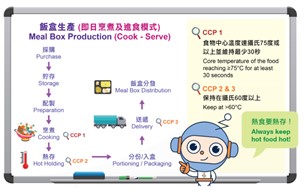
Figure 1: Schematic diagram and CCPs for meal box production
Overall speaking, there are three major CCPs for production of hot-served meal boxes, namely cooking, hot holding and delivery. Pathogens may be present in raw food ingredients. Foods that are not thoroughly cooked may contain these pathogens and cause food poisoning. Therefore, all foods should be thoroughly cooked with the core temperature reaching 75°C or above for at least 30 seconds. Using a clean food thermometer to measure the core temperature of food is the best way to judge whether the food is adequately cooked for safe consumption. Where possible, cook all food ingredients, including sauces and soup, on the day of consumption. Caterers should also avoid preparing food too far in advance before consumption.
After cooking, food items in meal boxes should be packed in clean insulated containers as quickly as possible to prevent cross-contamination and kept at above 60°C for delivery. If meal boxes are not packed immediately, keep them in warming devices at above 60°C. It should be noted that insulated containers generally do not have any heating elements, and they simply trap the heat of the food and stop it from escaping. Therefore, it is advisable to preheat the hot-holding equipment by suitable and feasible means before putting meal boxes in it. Caterers have the responsibility to ensure that meal boxes are consistently kept at above 60°C during transit and upon delivery to the destination for consumption. To keep food warm, the time taken for delivery of meal boxes to the destination after completion of production should be shortened as far as practicable. Alternatively, electric warming trolleys can be used to keep food consistently hot before consumption. Caterers should remind their customers to consume delivered food quickly when it arrives.
Bacillus Cereus in Meal Boxes
Bacillus cereus is a spore-forming bacterium. Its spores can survive normal cooking temperatures. If cooked food is left at ambient temperatures for a prolonged period, the vegetative cells of Bacillus cereus will have the opportunity to multiply in large numbers and may eventually produce toxins which can cause food poisoning. However, the growth of Bacillus cereus can be restricted if cooked food is held hot at above 60°C.
For more relevant information, please visit the following website to browse the reference document ("Developing a school food safety plan based on HACCP system (for school lunch box caterers)") produced by the Centre for Food Safety (CFS):
https://www.cfs.gov.hk/english/programme/programme_haccp/files/lunchbox.pdf

Mascot ON in Lesson
Food Safety Risks of Raw Oysters
Many people love to eat raw oysters for their rich seawater flavour. However, we should bear in mind that raw and partially cooked oysters are basically high-risk foods.
Oysters filter seawater for food. Harmful microorganisms, including viruses (e.g. norovirus and Hepatitis A virus) and bacteria (e.g. Vibrio parahaemolyticus and Vibrio vulnificus), may accumulate in their tissues. These are foodborne pathogens that can cause symptoms like vomiting, nausea, diarrhoea, headache and fever in humans. The consequence can be serious.
Acute toxicity resulting from consumption of such contaminated food is uncommon, but chronic exposure to heavy metals can have adverse health effects. The severity of toxic effects of heavy metals on humans varies according to the type of metals and the amounts taken. For example, cadmium is harmful to the kidney and lead is associated with neurodevelopmental disorders.
Health Advice from Mascot ON:
- All oysters should be obtained from reliable sources with health certificates issued by relevant authorities of the places of origin.
- Selling raw oysters requires written permission or endorsement from the Director of Food and Environmental Hygiene.
- Source oysters that are grown in and harvested from clean waters.
Spot Check
Excessive Coagulase-positive Staphylococci Organisms in Sample of Chicken Soup with Maitake Mushrooms and Figs
On 29 April 2021, the CFS announced a food complaint case which involved a restaurant in Lok Fu. As revealed by preliminary investigation, the incriminated food was suspected to be chicken soup with maitake mushrooms and figs. The sample taken from the restaurant was found to contain coagulase-positive staphylococci at a level of 16,000 organisms per gram. Under the Microbiological Guidelines for Food, ready-to-eat food that contains coagulase-positive staphylococci at a level of more than 10,000 organisms per gram is considered unsatisfactory.
Coagulase-positive Staphylococci Organisms
Coagulase-positive staphylococci organisms can produce enterotoxins that cause food poisoning. The common symptoms include nausea, vomiting and abdominal pain, often accompanied by diarrhea.
Advice to the Trade
- Estimate the demand of each type of soup carefully to avoid over-production. Plan the cooking time ahead to avoid preparing the soup too soon.
- Use different clean utensils to handle raw, cooked and ready-to-eat food separately.
- When preparing or reheating soup, bring it to a boil and keep boiling for at least one minute.
- For cooling of cooked soup, reduce the temperature from 60℃ to 20℃ as soon as possible (within 2 hours) and further from 20℃ to 4℃ in no more than 2 hours (the whole cooling process should not exceed 4 hours).
- Keep cooked soup at 60℃ or above if it is not intended to be served immediately.
- Maintain good personal hygiene practices and minimise direct hand contact with ready-to-eat foods.
Safe Kitchen/Trade Talks/Food Safety Guidelines
Introduction to "Safe Kitchen" Scheme
To facilitate trade members in adopting the "5 Keys to Food Safety" and good hygienic practices to enhance food safety in daily operation, the CFS has integrated the existing channels of risk communication to launch a new platform, namely "Safe Kitchen", to communicate with the trade. The platform serves to provide food safety information of greater practical importance to meet the operational needs of catering outlets.
The "Safe Kitchen" platform disseminates up-to-date food safety information (including food safety guidelines and relevant legislative amendments) to the trade through a host of channels including WhatsApp, emails and dedicated websites. In response to food poisoning outbreaks in restaurants, the platform will also issue food alerts to remind the trade of the points to note in preventing future occurrences so that the risk of food poisoning can be minimized.
New dedicated websites and risk information exchange platforms will be rolled out under the "Safe Kitchen" Scheme. In addition, training materials tailor-made for the trade and different workshops for kitchen staff will be provided to enhance food safety and hygiene awareness among food handlers.
Members of the trade are welcome to scan the following QR code to download the registration form for the "Safe Kitchen" Scheme in order to receive the latest food safety information in a timely manner.

"Safe Kitchen" Trade Talks
At present, catering services for the elderly and people with weakened immunity are provided by many different organisations, including residential care homes for the elderly (RCHEs), district elderly community centres, integrated home care service agencies, day care centres for the elderly, residential care homes for persons with disabilities (RCHDs) and day rehabilitation centres. As there is a great variety of food and senior citizens and persons with weakened immune systems are usually more vulnerable to diseases, food handlers should pay attention to various risk factors when preparing meals for them in order to protect their health.
To enable institutions to provide catering services for the elderly and people with weakened immunity, the CFS, the Department of Health and the Social Welfare Department co-organised two infection control courses separately for staff members of RCHEs and RCHDs on 25 August 2021. The courses could enhance awareness on prevention of transmission of multidrug-resistant organisms and promote food safety among the staff.
Food Safety Guidelines
1. Fresh Fruit and Vegetable Juices
Fresh fruit and vegetable juices refer to juices that are extracted from fresh fruits and vegetables (e.g. oranges, apples, carrots and celery) and are prepared and sold in the same premises without undergoing any pasteurisation process. As pathogenic bacteria may be present in fruits and vegetables while toxins such as patulin may be found in mouldy ones, improper handling of fruit and vegetable juices may lead to food poisoning. To ensure food safety, food handlers should be alert to possible food safety problems when extracting juices and take appropriate preventive measures. Members of the trade may click the following link to draw reference from the relevant guidelines:
https://www.cfs.gov.hk/english/multimedia/multimedia_pub/files/control_juices.pdf

2. Flavoured Ice Beverages
Flavoured ice beverages are popular drinks in sizzling summer. These beverages are made up of finely crushed ice mixed with flavourings, syrups and other ingredients. If they are not handled hygienically and stored properly, harmful bacteria may multiply rapidly and cause gastro-intestinal diseases. Apart from safety issues of the ingredients, there are other points to note during the preparation process with regard to hygiene of food and equipment/utensils and personal hygiene. The relevant guidelines are available at the following website for reference of the trade:
https://www.cfs.gov.hk/english/multimedia/multimedia_pub/files/flavoured_ice_beverages.pdf

3. Frozen Confections
According to the Frozen Confections Regulation (Cap. 132AC), frozen confection means any confection commonly sold for human consumption in a frozen or chilled state, such as ice-cream (including hard ice-cream and soft ice-cream served in retail outlets, as well as pre-packaged ice-cream in original cups and wrappers), frozen yoghurt and sundae.
Heat treatment is applied in the manufacturing of frozen confections to minimise microbiological hazards. However, heat-treated frozen confections may still be contaminated by microorganisms in the environment or other ingredients at any point during processing, packaging, storage, delivery and retailing. It is incumbent on the manufacturers to take effective preventive measures to ensure the food safety of their products. Members of the trade may refer to the link below in viewing the relevant guidelines:
https://www.cfs.gov.hk/english/multimedia/multimedia_pub/files/Frozen_Confections_e.pdf

4. Application for Shell Fish (Hairy Crab) Permit
Under the Food Business Regulation, save with the written permission of the Director of Food and Environmental Hygiene (DFEH), no person shall sell any restricted foods, including shell fish. The hairy crab is a kind of shell fish. In this connection, written permission must be obtained from the Food and Environmental Hygiene Department (FEHD) for the sale of hairy crabs. The FEHD has prepared a new permit for operators selling hairy crabs to apply. The permit requires that premises selling hairy crabs must comply with the relevant hygiene requirements, including the provision of a refrigerator and a wash-hand basin. Hairy crabs for sale must be obtained from lawful sources accompanied with health certificates acceptable to the DFEH and must be kept in a refrigerator to safeguard food safety. The licensee / permittee / person with written permission shall keep the health certificates and produce them for inspection upon demand by any health inspector. For online sale of hairy crabs, operators shall apply for a permit from the FEHD for selling restricted foods online. Traders should source hairy crabs from reliable suppliers and comply with the relevant regulatory requirements.
News on CFS
1 Resumption of Trade Consultation Forum
The 73rd meeting of the Trade Consultation Forum (TCF) which was suspended last year due to the epidemic was resumed 16 April 2021. The topics on the agenda included "Prevention of COVID-19 — Guidance on Disinfecting the Working Environment and the Food Package of Cold Stores at Import Level", "Trade Guidelines on Safe Preparation of Eggs and Egg Products" and "Tetrodotoxin and Regulation of Puffer Fish As Food in Other Jurisdictions".
The 74th meeting of the TCF was organised on 21 July 2021. The discussion topics included "Harmful Substances in Food (Amendment) Regulation 2021", "Food Safety of Meal Box Production and Delivery", "Risks of Raw and Undercooked Seafood", "Microbiological Quality of Roast Meats When They Are Kept at Ambient Temperature for a Prolonged Period of Time", "Issues Relating to Use of Preservatives in Food" and "Updated Guidelines on Control Measures for Food Imported by Sea at Kwai Chung Customhouse".
The TCF provides a platform for the CFS to exchange views on food safety matters with the trade. The above meetings were conducted online through video conferencing with simultaneous interpretation service provided in English. Please browse the following webpages for details of the TCF:
http://www.cfs.gov.hk/english/committee/committee_tcf_2021.html
https://www.cfs.gov.hk/english/committee/Notes_and_Presentation_Materials_TCF74_20210721.html
2 Technical Meetings on Harmful Substances in Food (Amendment) Regulation 2021
The Harmful Substances in Food (Amendment) Regulation 2021 (the Amendment Regulation) was gazetted on 11 June 2021. The Legislative Council has completed scrutiny of the legislation.
The Amendment Regulation aims at strengthening regulatory control of three mycotoxins in food and setting/updating the maximum levels for five other harmful substances (i.e. benzo[a]pyrene, glycidyl fatty acid esters, melamine, 3-monochloropropane-1,2-diol and erucic acid) in edible fats and oils, condiments and formula products for infants. With reference to the recommendations of the World Health Organization (WHO), the Amendment Regulation also lists partially hydrogenated oils, the main source of industrially-produced trans fatty acids (IP-TFAs), as prohibited substances in food, with a view to meeting the WHO’s goal of eliminating IP-TFAs from the global food supply by 2023.
The CFS held three technical meetings with trade members and other stakeholders on 27 January, 26 March and 25 June 2021 to discuss technical issues related to the Amendment Regulation. Please refer to the following website for details:
www.cfs.gov.hk/harmfulsubstance
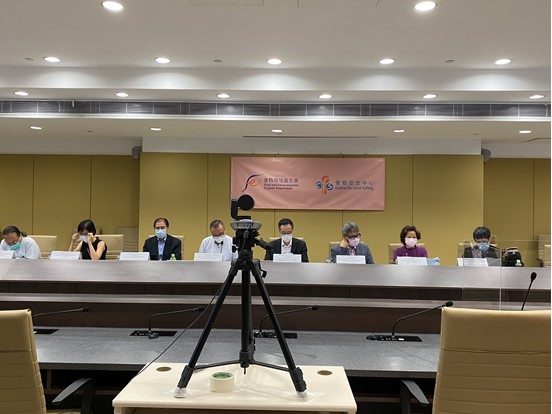
3 Release of Findings of Food Surveillance Programme
At a press conference held by the CFS on 20 July 2021, Dr TSUI Lok-kin, Edwin, Controller of the CFS, along with Dr LEUNG Ching-kan, Jackie, Assistant Director (Risk Management) and Dr YEUNG Tze-kiu, Samuel, Consultant (Community Medicine) (Risk Assessment and Communication) of the Food and Environmental Hygiene Department (FEHD), released the findings of the Summer Food Surveillance Programme 2021. According to the information, except for three samples (one of venus clam, one of clam and one of common oriental clam) detected with chloramphenicol (a veterinary drug), all other samples passed the microbiological tests and tests for metallic contaminants and veterinary drug residues. The overall satisfactory rate was 99.85%. The CFS has taken follow-up actions on the unsatisfactory samples, including instructing vendors to stop selling the food products concerned and remove them from the shelves, tracing the food sources and informing the relevant authorities of the places of origin. The CFS also reminded the public to patronise licensed and hygienic restaurants when dining out. In addition, food premises selling sushi, sashimi or other high-risk foods require a special permit. When buying these foods, the public should only patronise food premises issued with relevant licences/permits by the FEHD.
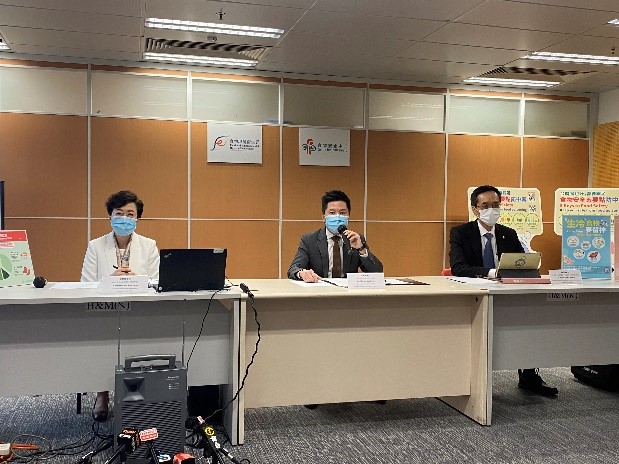
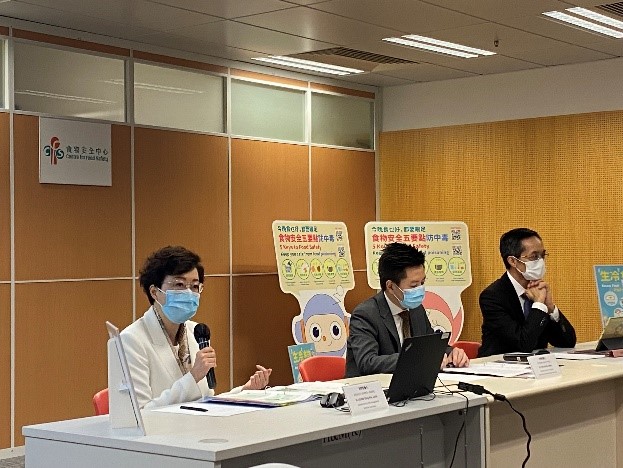
Ask Our Mascots
Suspected Food Poisoning Case Related to Consumption of Puffer Fish
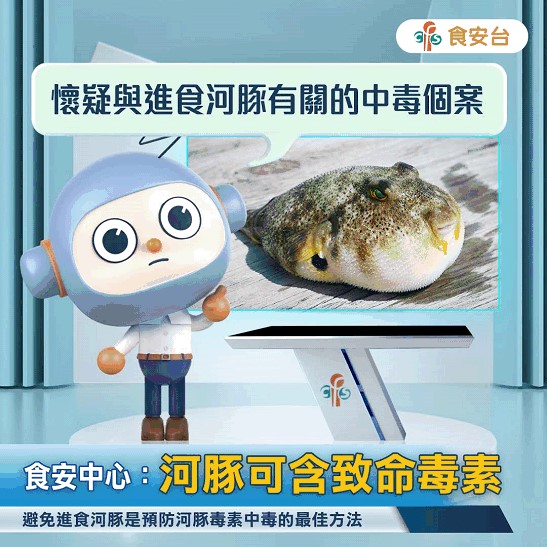
Mandy: Recently, there was a food poisoning case suspected to be caused by the consumption of puffer fish in a restaurant. What is puffer fish?
ON: Puffer fish is commonly known as globefish. It contains a potent toxin called tetrodotoxin, which is lethal to humans in a dose of around 1 to 2 mg. Tetrodotoxin is very heat-stable and is likely to remain in fish tissues even after a puffer fish is thoroughly cooked. Apart from puffer fish, other fish such as porcupine fish may also contain tetrodotoxin.
Mandy: According to what you say, it is really risky to eat puffer fish.
ON: Exactly. That's why the CFS advises the public not to buy puffer fish and other unknown fish, or catch, dissect and clean them on their own. They should also avoid eating these fish. As for the trade, traders should take note that the law in Hong Kong requires that all food for sale in the market must be fit for human consumption. They should ensure that fish and fish products imported for sale in Hong Kong are safe for consumption by consumers.
Knowledge Improvement Quiz
-
In which year was the CFS established?
a. 2000
b. 2006
c. 2018
-
What is the point to note in consuming raw oysters?
a. Follow food reviews to partronise whatever shops we like for purchase/consumption of raw oysters.
b. It is alright to eat a lot of raw oysters at a time as they are delicious.
c. Raw oysters must be cooked thoroughly before consumption.
-
Which of the following statements about tetrodotoxin (TTX) is correct?
a. TTX is very heat-stable and is likely to remain in fish tissues even after a puffer fish is thoroughly cooked.
b. TTX is only found in puffer fish.
c. TTX is not a powerful toxin. Humans will not die because of exposure to TTX.Answers:
Answers:
1) b 2) c 3) a
Diary of Mascot ON
15th Anniversary of CFS
#MUI: ON, let me give you a quiz. Do you know how long the CFS has been established?
#ON: That's easy. This year marks the 15th anniversary of the CFS. Let me tell you its history.
The CFS was established under the FEHD on 2 May 2006 with a view to enhancing food safety control and meeting public expectations for better food safety standards. It adopts the science-based risk analysis approach promulgated by international food safety authorities to strengthen food safety control in various stages of the food chain. Stepping into its 15th anniversary, the CFS has introduced a new video in the year featuring its work on the food safety front. Please click the following link or scan the QR code on the right to watch the video for more information about the CFS:
https://www.cfs.gov.hk/english/aboutus/aboutus_iv/aboutus_iv.html
